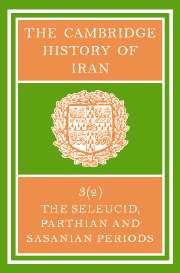28 - PARTHIAN ART
from PART 7 - ART HISTORY
Published online by Cambridge University Press: 28 March 2008
Summary
The Macedonian conquest of the Orient (334-323 b.c.) suddenly turned Achaemenian Iran into hellenized Iran. For a better understanding of the effects of this change on the arts, it seems necessary briefly to look back on what Achaemenian art had been. In the 6th century b.c., with the Achaemenians achieving for the first time the political unity of the civilized countries of the Ancient Near East, the arts of this area had reached the last stage of their development. At Pasargadae under Cyrus, at Susa and Persepolis under Darius, great palaces had been raised, whose architecture and decoration reflected and blended the various national traditions of the conquered countries: of Mesopotamia, of Egypt, of Anatolia, and even of the Asiatic Greeks.
The purpose of these great sovereigns had been to provide adequate seats for the “universal”, supranational power which Ahura Mazda had granted them. In spite of their architects heavily borrowing from foreign arts, the palaces may be said to be original creations by the peculiar way in which these foreign elements are associated and combined together into a harmonious and new synthesis. It might be suggested that just as the Achaemenian sovereign assumed the new position of a “King of kings”, Achaemenian art was conceived as an “Art of arts”, drawing, by deliberate choice, from the national arts of the Orient, some techniques, architectural forms, figurative or ornamental motifs, and rejecting no less deliberately other techniques, forms and motifs, which, although traditional in these arts, were not found convenient - an art, in short, “superior” to those national arts by reason of a resolute purpose of borrowing from each only “the best”.
- Type
- Chapter
- Information
- The Cambridge History of IranSeleucid Parthian, pp. 1025 - 1054Publisher: Cambridge University PressPrint publication year: 1983
References
- 2
- Cited by



